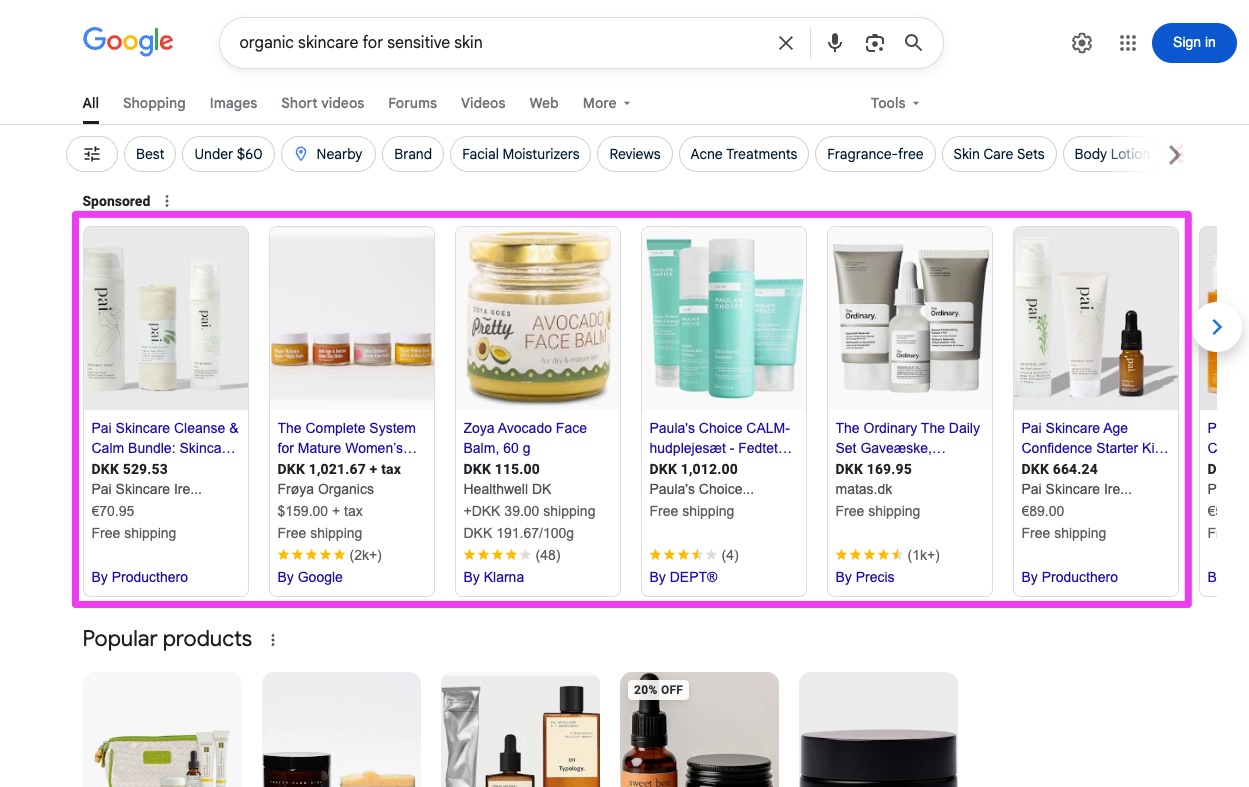Google Ads has come a long way, and it’s about to get even more advanced in 2025.
From manual bids and early automated strategies to the rollout of Smart Shopping and now Performance Max, the evolution has been dramatic.
There have been campaign wins and facepalms along the way.
But if you’re here, you want to know how to do it right for ecommerce in 2025.
Let’s get started.
Why Google Ads Still Matters for Ecommerce
When someone is searching for a product online, there’s usually clear purchase intent.
That is why paid search ads continue to be important.
In 2025, it isn’t just about searching on Google; it involves running campaigns across several platforms that feed into one hub of data and AI-powered insights.
Businesses can grow from a few daily orders to thousands because Google Ads helps you reach people who are already considering a purchase.
If someone types in “organic skincare for sensitive skin,” they are likely ready to buy.
That is exactly why your ads need to appear.

Automation is handling more of the work than ever before.
The algorithms learn from user behavior, your product feed, and your creative assets.
Done right, it becomes very effective.
Done wrong, you end up spending money without a return.
Embracing AI (But With Your Hands on the Wheel)
AI is not optional any longer. Automatic bidding strategies like Target ROAS and Maximize Conversions can produce results very quickly.
However, if you think you can simply switch it on without any oversight, you could overspend.
Key Steps to Make AI Work for You
- Set Clear GoalsBefore you launch a campaign, define what success looks like. Are you aiming for a specific ROAS? Perhaps your focus is on acquiring new customers rather than short-term profits. Specify your objectives by choosing the right bidding strategy.
- Accurate Conversion TrackingDon’t rely on default settings. Ensure your goals (whether they are sales, sign-ups, or phone calls) are tracked correctly. AI won’t optimize well if it is fed incorrect data.
- Use Strong Creative AssetsThe algorithm can test headlines, images, and descriptions across networks like Search, Display, and YouTube. Provide a good variety of high-quality materials so that the AI has plenty to work with.
I once took over an account where the previous agency set up Maximize Conversions but did not track sales correctly.
They were counting every “Add to Wishlist” as a conversion. It was confusing.
After we fixed the conversion tracking, performance improved in less than a week.
Performance Max & Shopping Campaigns
In 2025, Performance Max is a key tool for ecommerce.
It has replaced Smart Shopping by automating ad delivery across almost all Google properties - Search, Display, YouTube, Gmail, and the Discovery Network.
If you are not using Performance Max, you miss out on consolidated reach and the full abilities of AI.
I have seen businesses triple their store visits because Performance Max reached relevant audiences that they had not thought of before.
Why the Product Feed Is Essential
Your Google Merchant Center product feed informs the AI about what you sell.
Outdated product titles, missing keywords, or vague descriptions mean Google cannot match your products to search queries effectively.
I have seen entire campaigns suffer because the product feed had errors like missing GTINs or inconsistent pricing.
2 Ways to Improve Your Product Feed
Firstly, there is simply updating your feed manually, which can be done like so, but can take up days to improve once:
- Add detailed keywords in your product titles.
- Provide accurate product categories (using Google’s taxonomy).
- Include several high-quality images.
- Update pricing and availability daily.
I had a client who sold hiking backpacks. After improving their product feed by adding specific terms such as “lightweight,” “water-resistant,” and “trail-tested,” their Shopping Ads click-through rate increased by 40%.
That one change made an immediate difference.
The easier and my personal way of doing it is by using a feed optimization tool like SEO.AI.
Tools like SEO.AI simply update your feed base don real search data and creates all the attributes you need for your feed, and optimizes existing ones, and it only takes about 10 minutes max to get it done.

These tools are new but change the game for feed optimization going forward.
Sophisticated Audience Segmentation
Simply grouping all your visitors into one “remarketing” list is not enough.
Although AI can handle broad targeting fairly well, you get improved outcomes when you divide your audiences by behavior, purchase history, and even location.
My Favorite Segments to Use
- Cart Abandoners: People who added items to their cart.
- Repeat Visitors: Users who visited several times but have not purchased.
- Lapsed Customers: Those who made a purchase a while ago but have not returned.
- High-Spend Customers: The top 5-10% of buyers known for larger orders.
Each segment can respond to different messaging. For cart abandoners, a sense of urgency or a small discount might work best.
For high-spend customers, highlighting exclusive products can be effective. Tailoring your message improves ad relevance and boosts conversions.
Nested Audience Lists
A common tactic is to layer RLSA (Remarketing Lists for Search Ads) on top of keyword campaigns.
That way, if a previous visitor searches for the same keywords again, Google increases the bid. That combination of AI and segmentation can lead to substantial gains.
Automated Recommendations & Insights
If you are not using Google’s built-in recommendations, you might miss out on useful advice. In 2025, these recommendations are more accurate than ever, offering:
- New keyword opportunities based on current trends.
- Suggestions for refining your bid strategies.
- Advice on improving your ad extensions or responsive ad formats.
I used to dismiss these as a tactic to make advertisers spend more, but now they often highlight valuable changes that might otherwise be overlooked.
It is wise to review them weekly. I have discovered useful ideas, such as negative keyword suggestions that saved a client thousands in wasted clicks.
Common Automated Recommendations vs. My Response
I rarely act on these suggestions without checking first.
Integrating with Google’s Ecosystem
Previously, you could set up Google Analytics with minimal effort and still run acceptable campaigns.
In 2025, the integration between Google Analytics (GA4), Merchant Center, and your Ads campaigns is essential.
You need consistent tracking, robust attribution models, and real-time data flow.
Google Analytics 4 (GA4)
GA4’s event-based tracking offers a detailed view of user behavior, including scroll depth, clicks, and video engagement.
Feeding these signals into Google Ads strengthens the AI’s ability to segment effectively.
Merchant Center
An updated Merchant Center feed is critical for any Shopping campaign.
The feed must be error-free, optimized for search, and updated frequently to reflect changes in inventory.
Here is an example of a product from an outdoor store:
<rss version="2.0" xmlns:g="http://base.google.com/ns/1.0">
<channel>
<title>Outdoor Journey Store</title>
<link>https://www.adventuregearpro.com</link>
<description>Gear and apparel for camping, hiking, and backpacking</description>
<item>
<g:id>TL-1001</g:id>
<g:structured_title>
<g:digital_source_type>trained_algorithmic_media</g:digital_source_type>
<g:content>"Rest Under the Stars: AI-Enhanced TranquilLight Sleeping Bag (Regular)"</g:content>
</g:structured_title>
<g:structured_description>
<g:digital_source_type>trained_algorithmic_media</g:digital_source_type>
<g:content>"Stay warm on cool nights with the AI-Enhanced TranquilLight Sleeping Bag. Designed to retain heat while remaining breathable, it ensures restful sleep for backpackers and car campers alike."</g:content>
</g:structured_description>
<g:link>https://www.adventuregearpro.com/tranquillight-sleeping-bag</g:link>
<g:image_link>https://www.adventuregearpro.com/images/tranquillight_sleeping_bag.jpg</g:image_link>
<g:availability>in_stock</g:availability>
<g:price>99.99 USD</g:price>
<g:brand>TranquilLight</g:brand>
<g:color>Red/Grey</g:color>
<g:condition>new</g:condition>
<g:shipping>
<g:country>US</g:country>
<g:service>Standard</g:service>
<g:price>7.50 USD</g:price>
<g:min_transit_time>3</g:min_transit_time>
<g:max_transit_time>5</g:max_transit_time>
</g:shipping>
<g:shipping_weight>2.0 lb</g:shipping_weight>
</item>If an item is out of stock, your ads need to know right away to avoid paying for clicks on unavailable products.
I recall a boutique cosmetics store that experienced many refunds because half of their product feed had outdated pricing.
The leads were there, but the incorrect pricing caused confusion and order cancellations.
A simple feed update fixed the problem almost immediately.
Data-Driven Budget Allocation
Many ecommerce brands set one daily budget for all campaigns and call it a day. This method can leave potential revenue untapped.
It is better to allocate budgets by campaign type, stage in the sales process, or even by product category.
Here is one way to allocate budgets:
- Brand Campaigns: Generally low spend with high returns.
- Generic Search Campaigns: Medium to high spend depending on how profitable they are.
- Performance Max / Shopping: A significant portion of the budget if they consistently generate revenue.
- Remarketing / RLSA: Smaller budgets that usually yield high returns.
Using AI-driven insights, you can analyze performance at the campaign, product, and audience levels.
If a particular product line shows very high returns, consider increasing its budget. Let the numbers guide you, not just instincts.
Don’t Chase Daily Data
A common mistake in 2025 is adjusting campaigns daily because of immediate analytics.
I advise examining trends on a weekly or monthly basis.
AI bidding strategies need time to learn. Constant changes can disrupt that learning process right when a campaign is starting to perform well.
Real-World Wins and Discoveries
I closely follow case studies and a few examples stand out:
- Juicy Chemistry: By matching audience interests with global market data and using multi-market information, their orders increased by 150% thanks to a well-tuned Performance Max campaign with solid audience signals.
- Thegoodlife: They saw a 128% growth in revenue by actively filtering out unrelated search terms. The approach wasn’t just about broad matches; negative keywords and regular reviews of search queries were used.
- Gili Sports: Achieved $70,000 per week in sales using Shopping Ads as a main revenue driver. The secret was updating the product feed daily, allowing the AI to find new profitable search terms.
These examples show that while automation does a lot of work, it still needs careful oversight and accurate data.
Top Trends in 2025 You Can’t Ignore
Hyper-Local Targeting
Even if your business is primarily online, running local campaigns and using ZIP-code targeting can help you focus on areas where your brand works best.
Mobile searches for “near me” have increased significantly, and local inventory ads are useful if you have a physical store.
Interactive Shopping Ads
Text-only ads are a thing of the past.
Now it is possible to complete a purchase directly from ad units on YouTube or within certain Google search results.
A smooth buying process boosts conversions. If your website or checkout is slow, you risk losing these customers, so ensure your landing pages load quickly and work well on mobile devices.
Ongoing Creative Testing
Many clients set up responsive ads and then never check on them again. That is a mistake.
AI performs best when it has fresh creative material to test.
Whether it is new headlines, images, or short video clips, update your assets regularly to keep engagement high.
Handling Automation Transitions
Switching from manual campaigns to automated ones does not always go smoothly.
One challenge is that if you transition too quickly with insufficient data, the AI might not perform well.
For example, if you normally use manual CPC bidding on your best-selling products and then suddenly switch to Target ROAS with only 20 conversions under your belt, the algorithm will have to make guesses that may not be accurate.
What I Do Instead:
- Introduce automated bidding gradually, perhaps starting with one category or campaign.
- Gather at least 30-50 conversion actions from the last 30 days before making the switch.
- Run experiments side-by-side if needed.
In one case, an apparel brand tried Target ROAS on a portion of their product range.
Their conversion volume declined at first but recovered after about two weeks. Once performance was steady, we extended the strategy to all product lines.
Avoiding “Set and Forget”
Even after switching, check in regularly.
AI adjusts well but factors like new competitors or seasonal trends can affect performance, so I usually do weekly reviews with more extensive monthly adjustments.
Frequently Asked Questions About How to Do Google Ads
Here we answer the most asked question about how you do Google Ads efficiently:
1. How important is automation in Google Ads for ecommerce in 2025?
Automation is essential.
AI-driven bidding strategies like Target ROAS and Maximize Conversions can deliver strong results, but only if you set clear goals, track conversions accurately, and supply quality creative assets.
Oversight is still required because automation can waste budget if left unchecked.
2. What makes Performance Max campaigns a must-have for ecommerce?
Performance Max automates ad delivery across all major Google properties, consolidating reach and using AI to find high-intent shoppers.
It has replaced Smart Shopping and is now the backbone of effective ecommerce advertising.
A well-optimized product feed is critical for success with Performance Max.
3. How can I improve my product feed for better Shopping Ads performance?
Focus on detailed, keyword-rich product titles, accurate categories, multiple high-quality images, and daily updates to pricing and availability.
An optimized feed helps Google match your products to relevant searches, directly impacting click-through and conversion rates.
4. What audience segments should I target for the best results?
Go beyond basic remarketing. Segment audiences by cart abandoners, repeat visitors, lapsed customers, and high-spend buyers.
Tailor messaging for each group. Use urgency for cart abandoners and exclusivity for top spenders to boost relevance and conversions.
5. How should I allocate my Google Ads budget for ecommerce?
Do not just set a single daily budget. Allocate by campaign type: brand, generic search, Performance Max or Shopping, and remarketing.
Use AI insights to adjust budgets based on performance at the product and audience level. Avoid making daily changes and stick to weekly or monthly reviews.
6. What are the top trends in Google Ads for ecommerce in 2025?
Key trends include hyper-local targeting, interactive shopping ads that enable purchases directly from ad units, and ongoing creative testing. Regularly update your creative assets and embrace new ad formats to stay competitive and maximize results.
Want to try the #1 AI Toolkit for SEO teams?
Our AI SEO assistants helps write and optimize everything - from descriptions and articles to product feeds - so they appeal to both customers and search engine algorithms. Try it now with a free trial→

![How to Do Google Ads for Ecommerce in 2025 [All the Info You Need]](https://cdn.prod.website-files.com/627a5f477d5ec9079c88f0e2/6613aaaa53d5b53093f7b8b3_oskar-mortensen.jpg)










